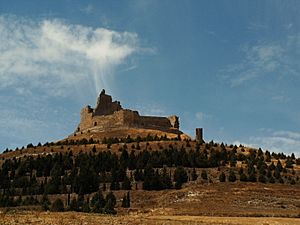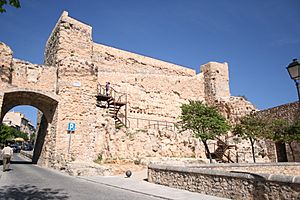Nuño Pérez de Lara facts for kids

Nuño Pérez de Lara (died August 3, 1177) was an important nobleman from the Kingdom of Castile (part of modern-day Spain). He was a skilled politician and military leader. Nuño started his career working for Emperor Alfonso VII. He helped settle new lands and defend the border against the Almohads. From 1164 to 1169, he was like a temporary ruler, or regent, for the young King Alfonso VIII. He kept a lot of power in the kingdom until 1176. Nuño also started two monasteries and helped spread the story of Thomas Becket in Spain. He died fighting in the Reconquista (reconquest) of Cuenca.
Contents
Who Was Nuño's Family?
Nuño was the third of four sons. His father was Pedro González de Lara, and his mother was Ava, who was likely from northern France. His older brothers were Álvaro and Manrique. He also had a younger brother named Rodrigo.
Before March 1154, Nuño married Teresa Fernández. She was the daughter of Fernando Pérez de Traba and Theresa, Countess of Portugal. Nuño and Teresa had several children together. Their children included Álvaro, Fernando, Gonzalo II, Sancha, and Elvira.
Nuño's Early Career and Roles
Nuño began his public life in February 1141. He signed an important document for a monastery. In March 1145, he became the emperor's alférez. This was a high military position, usually held by younger noblemen. Nuño held this job for a very long time, until February 1155.
In 1146, he was given his first fief, or land to govern, called Aguilar de Campoo. He also owned some houses in the important city of Toledo. In 1148, he gave these houses to Gonzalo de Marañón.
Settling New Lands
Nuño helped settle new towns. For example, he helped with the town of Castronuño (now Castronuño) in 1154. He worked with Bishop Navarro of Salamanca to build new churches and provide religious items. Nuño was in charge of bringing people to live in the village.
Between February and December 1154, Nuño was given control of Montoro. This was a frontier area, meaning it was on the border.
Defending the Frontier
As alférez, Nuño often stayed at the royal court. He usually governed his lands from a distance. However, in the spring of 1156, Montoro was attacked by the Almohads. Nuño was called to defend it. He was not successful. The fortress fell, and he was likely captured. He was not set free until January 1157.
After losing Montoro, he was given the tenencia (another type of land to govern) of Avia (possibly Abia de las Torres). He governed this land until his death.
More Lands and a Battle
In March 1156, Emperor Alfonso VII gave Nuño the village of Alcabón. In 1158, Nuño traded some of his lands with the Hospitallers. He exchanged his lands at Castronuño for theirs at Torre de Herrín.
In 1158, Alfonso gave Nuño the tenencia of Villagarcía. In 1160, he also received Cabezón (until 1173), Covillas (for a short time), and Herrera (until his death).
In 1160, Nuño and his brothers fought a battle at Lobregal. They fought against the rival Castro family. The Castros had been sent out of the kingdom earlier that year. Nuño's side lost the battle, and he was captured by Fernando Rodríguez de Castro.
Becoming a Count and Guardian
By March 1162, Nuño was given the important title of comes (count). His brother Manrique, who was then regent for the young King Alfonso VIII, likely gave him this title. That same year, Nuño was made a guardian, or tutor, for the king. He was given this responsibility again in 1172 and 1173. For this, he received the tenencias of Dueñas (until 1175) and Moratinos.
Nuño's Time as Regent and Later Years
When his brother Manrique died in 1164, Nuño took over as the regent of Castile. This meant he governed the kingdom for the young King Alfonso VIII. In 1165, he began governing the tenencias of Carrión (until 1176 or his death) and Villafáfila.
In March 1168, King Alfonso VIII placed the town of Chillón and its mercury mine under the control of both Nuño and the Order of Calatrava.
Continued Influence
On November 11, 1169, King Alfonso VIII became old enough to rule on his own. However, Nuño continued to be very involved in the kingdom's affairs. He remained influential until at least October 31, 1176.
In 1170, the king put Nuño in charge of Villavaquerín. Later, he was moved to San Román (1171), then Cuenca de Campos (1172–76), and Tamariz (1172). In 1173, Nuño was governing the tenencias of Amaya, Castrojeriz, Saldaña, and Tariego.
In May 1174, Nuño traded an estate with the monastery of Arlanza for the village of Huérmeces. That same year, a man named Bernard paid Nuño and Pedro de Arazuri 5,000 maravedíes to become the Bishop of Osma. This was a controversial way to get the position.
In 1176, Nuño received some houses in Toledo from the archbishop, Cerebruno. These houses had once belonged to Sancha Raimúndez. Nuño paid a small yearly rent for them. Nuño and his wife also gave some of their own houses near the imperial palace to the archbishop.
Death at Cuenca
In 1176, Nuño Pérez de Lara was appointed governor of the tenencias of Nájera, Ubierna, and Valeria. One year later, in July 1177, he was part of the siege of Cuenca. This was a military operation to capture the city. Nuño was killed in action a few weeks later, on August 3. His wife later went to the court of León and married King Ferdinand II.
Nuño's Support for Religious Places
On January 29, 1160, Nuño and his wife started the Cistercian convent of Santa María at Perales. They also gave it lands in Zorita.
In 1169, Nuño, his brother Álvaro, and others gave up their rights over the monastery of Aguilar de Campoo. They established some Augustinians monks there. They also moved properties from another monastery to Aguilar, which caused a disagreement that was fixed in 1173. Aguilar became a very important monastery in Spain.
Nuño was very generous to the cathedrals of the kingdom. He gave money and land to Santa María de León (1170), Santa María de Burgos (1174), and Santa María de Toledo. At Toledo, they built a chapel dedicated to Thomas Becket in 1174. They gave it more support in 1177, including the village of Alcabón, some houses in Toledo, twenty cows, and one hundred sheep. Nuño likely wanted to promote the story of Thomas Becket in Spain.
In 1172, he gave half of the village of Aceca to the Order of Calatrava. Sometime before 1174, Nuño and his wife also started a hospital. It was next to a monastery in Itero del Castillo. This hospital was for travelers on the Way of Saint James who crossed the Pisuerga river there.
See also
 In Spanish: Nuño Pérez de Lara para niños
In Spanish: Nuño Pérez de Lara para niños


